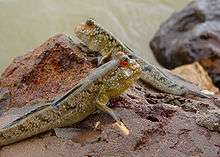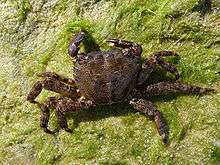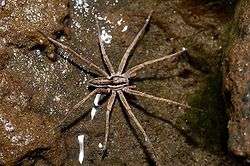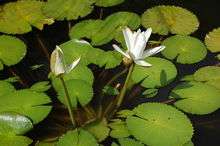Semiaquatic
In biology, semiaquatic can refer to various types of animals that spend part of their time in water, or plants that naturally grow partially submerged in water. Examples are given below.

Atlantic mudskippers, amphibious fish of mangrove swamps and tidal flats

Pachygrapsus marmoratus, a semiterrestrial crab

Hunting stance of Dolomedes minor, a semiaquatic spider
Semiaquatic animals
Semiaquatic animals include:
- Vertebrates
- Semiaquatic tetrapods
- Amphibious fish; also several types of normally fully aquatic fish such as the grunion and plainfin midshipman that spawn in the intertidal zone
- Semiterrestrial echinoderms of the intertidal zone, such as the "cliff-clinging" sea urchin Colobocentrotus atratus and the starfish Pisaster ochraceus
- Arthropods
- Aquatic insects (e.g., dragonflies) with at least one nonaquatic life-cycle stage (e.g., adults), or amphibious insects (e.g., amphibious caterpillars or the ant Polyrhachis sokolova).[note 1] Members of the hemipteran infraorders Gerromorpha and Nepomorpha occupy a variety of semiaquatic and aquatic niches, with many of the former locomoting on the water surface; a few of these are marine (e.g., Halobates, Hermatobates).
- Semiaquatic springtails, such as Anurida maritima
- Semiterrestrial malacostracan crustaceans (e.g., many crabs, such as Pachygrapsus marmoratus,[note 2] some amphipods, such as Orchestia gammarellus, some isopods, such as Ligia oceanica and some barnacles, such as Balanus glandula)
- Horseshoe crabs are mostly aquatic but spawn in the intertidal zone; juveniles live in tidal flats
- Semiaquatic spiders, such as Ancylometes or Dolomedes (these are distinct from the almost fully aquatic Argyroneta)
- An amphibious centipede, Scolopendra cataracta
- Semiaquatic annelids, such as the earthworm Sparganophilus
- Molluscs
- Intertidal bivalves, such as Enigmonia, which lives on mangroves
- Intertidal chitons, such as Acanthopleura granulata
- Semiterrestrial gastropods, such as the intertidal Patella vulgata, a limpet; also amphibious freshwater and marine snails, such as Pomatiopsis or Cerithideopsis scalariformis, respectively
- Semiterrestrial flatworms of the intertidal zone, such as the acotylean Myoramyxa pardalota[4]

The white Egyptian lotus, a semiaquatic angiosperm
Semiaquatic plants
- Semiaquatic angiosperms (e.g., mangroves, water spinach, water cabbage, and the entire order Nymphaeales)
- Semiaquatic conifers, such as pond cypress
- Semiaquatic ferns, such as Pilularia americana
- A semiaquatic horsetail, Equisetum fluviatile
- Semiaquatic quillworts, such as Isoetes melanospora
- Semiaquatic club mosses, such as Lycopodiella inundata
- Semiaquatic mosses, such as Sphagnum macrophyllum
- Semiaquatic liverworts, such as Riccia fluitans
Notes
- At least one individual of a normally fully terrestrial praying mantis species, Hierodula tenuidentata, has learned to opportunistically prey on fish.[1]
- Technically, most land crabs fall into this category, since most must return to bodies of water to release their eggs; the few exceptions, such as members of genus Geosesarma,[2] are found among the Grapsidae (sensu lato) and Potamoidea (sensu lato).[3]
gollark: Oh, wait, no, that is JS Being bad.
gollark: Which is 50 characters, sad.
gollark: RocketRace's name is now 𐙦鬠𒁯尼慡褠唬𒁣𓅮啴潎𓌠猸霨𓁡唺尦啡幔戠唾ꕩꍰ縠驴陲𒁴煲𓉉ꕥ逽尦啡灔茠獝𠄠挠挮𠌠.
gollark: oh *bee*
gollark: Yes, but not USABLE ones. Base131072 is in development pending more.
References
- Battiston, R.; Puttaswamaiah, R.; Manjunath, N. (2018). "The fishing mantid: predation on fish as a new adaptive strategy for praying mantids (Insecta: Mantodea)" (PDF). Journal of Orthoptera Research. 27 (2): 155–158. doi:10.3897/jor.27.28067.
- Tan, C.G.S.; Ng, P.K.L. (1995). "Geosesarma notophorum sp. nov. (Decapoda, Brachyura, Grapsidae, Sesarminae), a Terrestrial Crab from Sumatra, with Novel Brooding Behaviour". Crustaceana. 68 (3): 390–395. doi:10.1163/156854095X00557.
- Burggren, W.W.; McMahon, B.R., eds. (1988). Biology of the Land Crabs. Cambridge University Press. pp. 53–54. ISBN 978-0521306904.
- Newman, L.J.; Cannon, L.R.G. (1997-06-30). "A new semi-terrestrial acotylean flatworm, Myoramyxa pardalota gen. et sp. nov. (Plehniidae Polycladida) from southeast Queensland, Australia". Memoirs of the Queensland Museum. 42 (1): 311–314. Retrieved 2018-08-14.
This article is issued from Wikipedia. The text is licensed under Creative Commons - Attribution - Sharealike. Additional terms may apply for the media files.